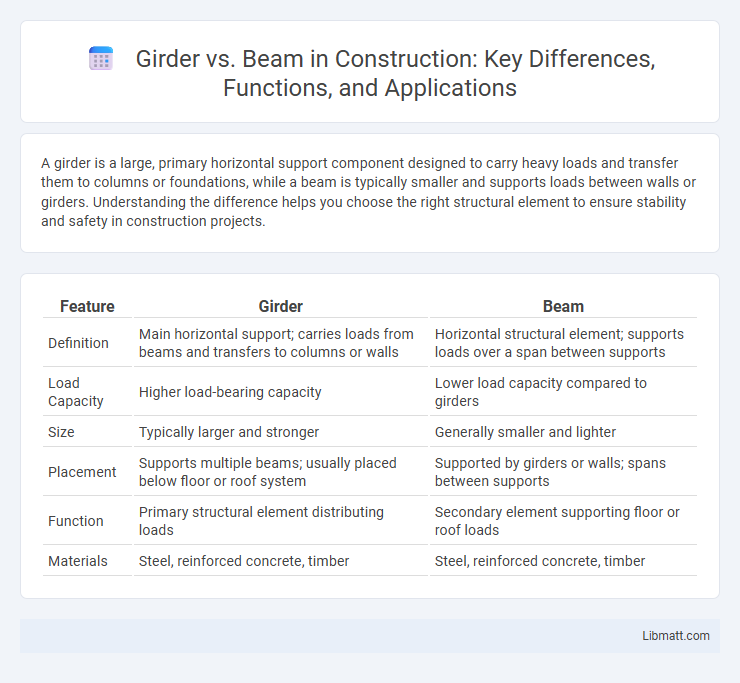A girder is a large, primary horizontal support component designed to carry heavy loads and transfer them to columns or foundations, while a beam is typically smaller and supports loads between walls or girders. Understanding the difference helps you choose the right structural element to ensure stability and safety in construction projects.
Table of Comparison
| Feature | Girder | Beam |
|---|---|---|
| Definition | Main horizontal support; carries loads from beams and transfers to columns or walls | Horizontal structural element; supports loads over a span between supports |
| Load Capacity | Higher load-bearing capacity | Lower load capacity compared to girders |
| Size | Typically larger and stronger | Generally smaller and lighter |
| Placement | Supports multiple beams; usually placed below floor or roof system | Supported by girders or walls; spans between supports |
| Function | Primary structural element distributing loads | Secondary element supporting floor or roof loads |
| Materials | Steel, reinforced concrete, timber | Steel, reinforced concrete, timber |
Introduction to Girders and Beams
Girders and beams are fundamental structural elements used to support loads in buildings and bridges, with girders typically serving as the main horizontal supports that carry heavier loads and transfer them to columns or piers. Beams, in contrast, span shorter distances and distribute loads from floors, roofs, or walls to the girders. Understanding the differences in load capacity and placement is essential for optimizing your construction project's structural integrity.
Definition of Girders
Girders are large, primary horizontal supports designed to carry heavy loads and span longer distances in construction, typically supporting smaller beams or joists. Unlike standard beams, girders often serve as the main structural framework in bridges, buildings, and industrial structures. Their robust design enables them to distribute weight effectively across multiple points, making them essential for stability in large-scale projects.
Definition of Beams
Beams are structural elements designed to withstand loads primarily through bending, typically supported at two or more points. Unlike girders which serve as main horizontal supports, beams distribute weight within the framework by carrying shear forces and bending moments across shorter spans. Your building's stability depends on the correct selection and placement of beams to effectively transfer loads to girders or columns.
Key Differences Between Girders and Beams
Girders are primary structural members that support beams and transfer loads to columns or foundations, typically larger and capable of bearing heavier loads than beams. Beams are secondary load-bearing elements designed to support smaller spans between girders, distributing loads primarily through bending. The main difference lies in their function and scale: girders act as main horizontal supports in a structure, while beams serve as intermediate supports within the girder framework.
Structural Roles in Construction
Girders and beams both play crucial structural roles in construction, with girders serving as the primary support elements that carry heavy loads from beams and transfer them to columns or foundations. Beams typically span shorter distances and distribute loads from floors, roofs, or walls to the girders. Your choice between a girder and a beam depends on the design requirements, load capacity, and span length critical to the structural integrity of the project.
Material Types Used
Girders are often constructed from steel or reinforced concrete due to their role as primary load-bearing structures in bridges and large buildings, requiring high strength and durability. Beams, while also made from steel and reinforced concrete, can additionally be fabricated from wood or engineered wood products in residential and lighter structural applications. The choice of material for girders and beams depends on factors like load capacity, span length, and environmental conditions, influencing their structural performance and longevity.
Common Applications
Girders and beams serve distinct roles in structural design, with girders commonly used as primary support elements in bridges, large buildings, and industrial structures to transfer heavy loads. Beams are typically found in residential and commercial buildings, supporting floors, roofs, and walls. Your choice between a girder and a beam depends on the scale of the project and load requirements.
Load-Bearing Capacities
Girders typically have higher load-bearing capacities than beams because they are designed to support and transfer heavy loads across larger spans, often accommodating multiple beams or structural elements. Beams primarily carry loads across shorter spans and distribute them to girders or columns, making their load capacity generally more limited. Understanding the distinction between girder and beam capacities helps you optimize structural design for safety and efficiency.
Advantages and Disadvantages
Girders offer superior load-bearing capacity and are ideal for supporting heavy structures, making them suitable for large-scale construction projects. Beams are more versatile and easier to install but may require additional support in heavy-load scenarios. Your choice depends on the specific structural requirements, balancing strength needs against installation complexity.
Choosing Between Girders and Beams
Choosing between girders and beams depends largely on load requirements and span length in structural design. Girders typically support heavier loads and longer spans, acting as primary structural members that carry the weight of beams and slabs, whereas beams are secondary members that transfer loads to girders or columns. For projects requiring substantial load-bearing capacity, such as bridges or large commercial buildings, girder selection ensures stability and efficiency, while beams suit shorter spans and lighter loads in residential or small-scale construction.
Girder vs beam Infographic

 libmatt.com
libmatt.com